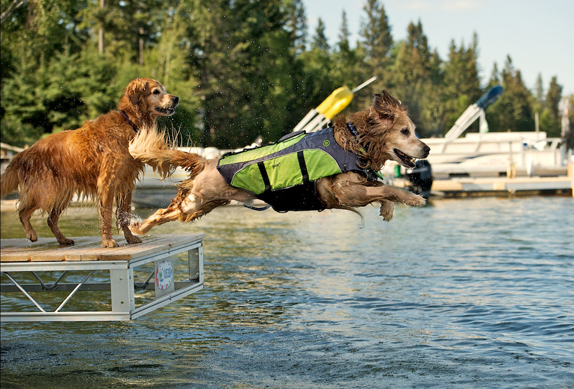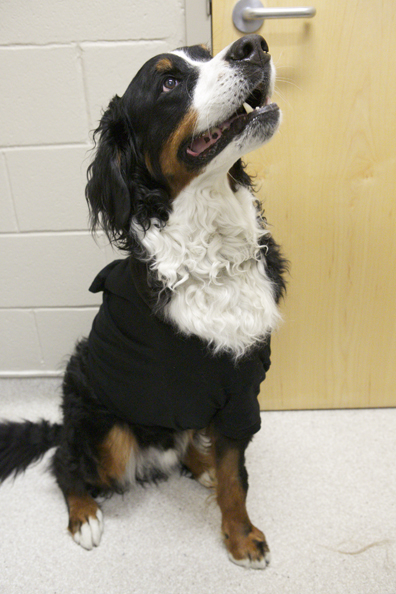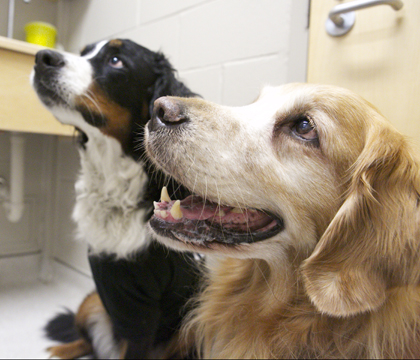"Oliver always got really excited when you threw his toy because he got to jump out into the water to retrieve it," explains Mohr. "But that day he got so excited that he went over the side unexpectedly. After he fell, we saw he was running on three legs, and we started to wonder if he had maybe dislocated his hip."
Mohr, an emergency room physician, and Leswick, a radiologist, took Oliver to the WCVM Veterinary Medical Centre for assessment. They were startled and dismayed when X-rays pointed to osteosarcoma, an aggressive bone cancer.
Magnus, a beautiful Bernese mountain dog, has a similar story. Owners Janine Johnson and Kurtis Klutz saw Magnus develop a persistent forelimb limp and took him in to their regular vet for a checkup. Like Oliver's owners, Magnus' owners are in the human medical field – Johnson is a chiropractor and Klutz is a physiotherapist. When they saw the X-rays, they knew they were facing a tough decision.
"Most dogs present with a lameness that can be sudden and noticeable, or intermittent. The cancer weakens the bone, which causes micro-fractures to occur," explains Dr. Valerie MacDonald, an associate professor of medical oncology in the WCVM's Department of Small Animal Clinical Sciences. MacDonald, along with oncology resident Dr. Kirsty Elliot, oversaw both Oliver and Magnus' care when they were referred to the WCVM.
Osteosarcoma, one of the most common canine cancers, typically affects large breed dogs that range in age from six to eight years old. It happens most often in appendicular bones, the long bones of the legs. By the time it's diagnosed, 90 per cent of cases will have microscopic metastases in the lungs. The metastases are too small to be seen on an X-ray.

The good (and somewhat surprising) news is that treatment options are readily available and have the potential to give dogs a good quality of life while living with cancer.
"Our first concern is always the animal's quality of life," says MacDonald. "We don't want the treatment to be worse than the disease." Treatment for osteosarcoma is usually straightforward: amputation of the affected limb, plus chemotherapy to control any metastasized cancer.
Surgeons amputated Magnus' right front leg and Oliver's right back limb. "Limb amputation accomplishes two goals," says MacDonald. "It removes the original tumour, and it removes the source of the pain." Unfortunately, removal of the tumour alone doesn't mean the patient is cured.
Forelimb amputations can be a bit tougher, as the forelimbs bear more weight. But many dogs that undergo amputation already have experience as "tripods" due to limb pain.
Both Oliver and Magnus had fairly uneventful recoveries after surgery. Oliver startled his vets by leaping from his kennel the first time he was let out for a bathroom break. Magnus took a little longer; he developed an infection at the surgical site that had to be re-opened.
Dogs also tend to have a very good response to chemotherapy drugs. Anti-nausea medication is provided, but many owners find they don't need it. Dogs also don't lose any fur, although shaved areas may grow back more slowly.

"There's a good chance you'll get another year with your pet, and there's a small chance you'll get longer than that. It was a tough decision but for us, it was worth it."
"Magnus did really well with the chemo — he wasn't sick at all," says Johnson. "The price of the chemotherapy drugs can be a consideration though. We chose a type of drug that was more expensive but had fewer side effects."
Owners also may not realize that while a pet is undergoing chemotherapy, bodily fluids and excrement qualify as medical waste and must be disposed of properly.
"You need to know your dog," adds Mohr. "I'm not sure our female retriever would be a good candidate for what Oliver went through. We knew his chances for a quality life were nil without amputation, and we knew we would be able to dedicate additional time and resources to his recovery if need be."
Mohr has nothing but praise for the WCVM's Small Animal Clinic. "I had to bring my two kids and our female dog to Oliver's appointments — my daughter asked tons of questions and the vet technician answered all of them."
She was also concerned that Oliver would be kenneled when he went for chemotherapy appointments but found that wasn't the case.
"The oncology dogs roam around and get attention all day long. Oliver loved going to the vet college. Whatever they're doing there, they're doing right."
Magnus initially had to be lifted by Klutz into the family vehicle, but in the past few months, Johnson says he has nearly returned to being the same happy, healthy dog that he was before his surgery.
"When we are out and about, most people don't even notice that he's a tripod. He goes for 45-minute-plus walks easily, swims at the dog pool like he has four legs and has thighs of steel . . . he is pretty unbelievable," says Johnson, adding that Magnus' first post-chemotherapy checkup went well.
"There's a good chance you'll get another year with your pet, and there's a small chance you'll get longer than that. It was a tough decision but for us, it was worth it."
For Oliver, amputation extended his life for another six months. After the surgery, he returned to jumping off the dock and accompanying Mohr on her stand-up paddleboard. The only difference was that his owners decided he should wear a life jacket when he was on the water.
"He did a five-kilometre run for breast cancer with me in the fall," says Mohr. "But I think he actually did six kilometres because he had to zigzag over the course and schmooze with everyone."
A few months later, Mohr and Leswick made the difficult decision to humanely euthanize Oliver once he developed significant clinical signs indicating that the cancer had spread to his lungs. After they said good bye to their beautiful dog, "Ollie" died at home on December 30, 2012.
Read about how canine cancer researchers are teaming up with their colleagues in the human health field.
Mohr, an emergency room physician, and Leswick, a radiologist, took Oliver to the WCVM Veterinary Medical Centre for assessment. They were startled and dismayed when X-rays pointed to osteosarcoma, an aggressive bone cancer.
Magnus, a beautiful Bernese mountain dog, has a similar story. Owners Janine Johnson and Kurtis Klutz saw Magnus develop a persistent forelimb limp and took him in to their regular vet for a checkup. Like Oliver's owners, Magnus' owners are in the human medical field – Johnson is a chiropractor and Klutz is a physiotherapist. When they saw the X-rays, they knew they were facing a tough decision.
"Most dogs present with a lameness that can be sudden and noticeable, or intermittent. The cancer weakens the bone, which causes micro-fractures to occur," explains Dr. Valerie MacDonald, an associate professor of medical oncology in the WCVM's Department of Small Animal Clinical Sciences. MacDonald, along with oncology resident Dr. Kirsty Elliot, oversaw both Oliver and Magnus' care when they were referred to the WCVM.
Osteosarcoma, one of the most common canine cancers, typically affects large breed dogs that range in age from six to eight years old. It happens most often in appendicular bones, the long bones of the legs. By the time it's diagnosed, 90 per cent of cases will have microscopic metastases in the lungs. The metastases are too small to be seen on an X-ray.

The good (and somewhat surprising) news is that treatment options are readily available and have the potential to give dogs a good quality of life while living with cancer.
"Our first concern is always the animal's quality of life," says MacDonald. "We don't want the treatment to be worse than the disease." Treatment for osteosarcoma is usually straightforward: amputation of the affected limb, plus chemotherapy to control any metastasized cancer.
Surgeons amputated Magnus' right front leg and Oliver's right back limb. "Limb amputation accomplishes two goals," says MacDonald. "It removes the original tumour, and it removes the source of the pain." Unfortunately, removal of the tumour alone doesn't mean the patient is cured.
Forelimb amputations can be a bit tougher, as the forelimbs bear more weight. But many dogs that undergo amputation already have experience as "tripods" due to limb pain.
Both Oliver and Magnus had fairly uneventful recoveries after surgery. Oliver startled his vets by leaping from his kennel the first time he was let out for a bathroom break. Magnus took a little longer; he developed an infection at the surgical site that had to be re-opened.
Dogs also tend to have a very good response to chemotherapy drugs. Anti-nausea medication is provided, but many owners find they don't need it. Dogs also don't lose any fur, although shaved areas may grow back more slowly.

"There's a good chance you'll get another year with your pet, and there's a small chance you'll get longer than that. It was a tough decision but for us, it was worth it."
"Magnus did really well with the chemo — he wasn't sick at all," says Johnson. "The price of the chemotherapy drugs can be a consideration though. We chose a type of drug that was more expensive but had fewer side effects."
Owners also may not realize that while a pet is undergoing chemotherapy, bodily fluids and excrement qualify as medical waste and must be disposed of properly.
"You need to know your dog," adds Mohr. "I'm not sure our female retriever would be a good candidate for what Oliver went through. We knew his chances for a quality life were nil without amputation, and we knew we would be able to dedicate additional time and resources to his recovery if need be."
Mohr has nothing but praise for the WCVM's Small Animal Clinic. "I had to bring my two kids and our female dog to Oliver's appointments — my daughter asked tons of questions and the vet technician answered all of them."
She was also concerned that Oliver would be kenneled when he went for chemotherapy appointments but found that wasn't the case.
"The oncology dogs roam around and get attention all day long. Oliver loved going to the vet college. Whatever they're doing there, they're doing right."
Magnus initially had to be lifted by Klutz into the family vehicle, but in the past few months, Johnson says he has nearly returned to being the same happy, healthy dog that he was before his surgery.
"When we are out and about, most people don't even notice that he's a tripod. He goes for 45-minute-plus walks easily, swims at the dog pool like he has four legs and has thighs of steel . . . he is pretty unbelievable," says Johnson, adding that Magnus' first post-chemotherapy checkup went well.
"There's a good chance you'll get another year with your pet, and there's a small chance you'll get longer than that. It was a tough decision but for us, it was worth it."
For Oliver, amputation extended his life for another six months. After the surgery, he returned to jumping off the dock and accompanying Mohr on her stand-up paddleboard. The only difference was that his owners decided he should wear a life jacket when he was on the water.
"He did a five-kilometre run for breast cancer with me in the fall," says Mohr. "But I think he actually did six kilometres because he had to zigzag over the course and schmooze with everyone."
A few months later, Mohr and Leswick made the difficult decision to humanely euthanize Oliver once he developed significant clinical signs indicating that the cancer had spread to his lungs. After they said good bye to their beautiful dog, "Ollie" died at home on December 30, 2012.
Read about how canine cancer researchers are teaming up with their colleagues in the human health field.
Share this story
